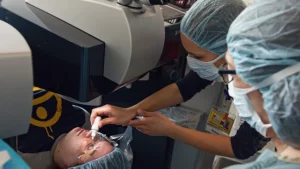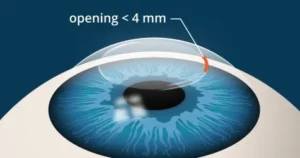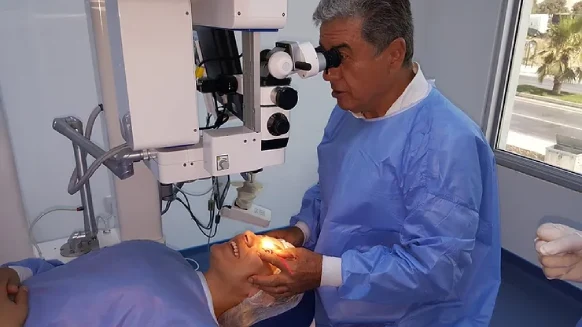Have you ever imagined a world where you wouldn’t need to rely on your glasses or contact lenses every day? Laser eye surgery is one solution that has made this dream a reality for millions of people worldwide. But what exactly is laser eye surgery, and what types are available? This article will demystify the world of laser eye surgeries, making it easier for you to make an informed decision.
Contents
What Are The Different Types Of Laser Eye Surgery?
Here, we explore the different types of laser eye surgery, to help you make an informed decision about the best procedure for you.
LASIK (Laser In-Situ Keratomileusis)
 LASIK is a highly popular type of laser eye surgery. This procedure uses two lasers. The first one, a femtosecond laser, is used to create a thin flap in the cornea. The surgeon then lifts this flap to expose the underlying cornea. The second laser, an excimer laser, is used to reshape this corneal tissue, correcting the refractive error. The flap is then repositioned, which aids in the healing process.
LASIK is a highly popular type of laser eye surgery. This procedure uses two lasers. The first one, a femtosecond laser, is used to create a thin flap in the cornea. The surgeon then lifts this flap to expose the underlying cornea. The second laser, an excimer laser, is used to reshape this corneal tissue, correcting the refractive error. The flap is then repositioned, which aids in the healing process.
Pros and Cons of LASIK
- Pros: LASIK offers a fast recovery, minimal pain, and a high success rate in achieving 20/20 vision.
- Cons: LASIK may not be suitable for people with thin corneas. There’s a small risk of complications, such as dry eyes and glare.
Epi-LASIK
Epi-LASIK is another innovative variant in the world of laser eye surgeries. The surgeon performs this procedure by separating a thin layer of the cornea (epithelium) using a special device called an epi-keratome. Unlike in LASIK, the surgeon doesn’t create a corneal flap here, which makes Epi-LASIK a good option for people with thin corneas.
Once the surgeon separates the epithelial layer, they use an excimer laser to reshape the underlying cornea and correct the refractive error. Finally, they reposition the epithelial layer back onto the eye, where it adheres naturally during the healing process.
Pros and Cons of Epi-LASIK
- Pros: Epi-LASIK eliminates the risk of flap complications seen in LASIK. It’s also a good option for people with thin or unusually shaped corneas or those who have a lifestyle or occupation that makes a corneal flap risky.
- Cons: Recovery from Epi-LASIK may take longer than LASIK, and some people may experience more discomfort during the healing process.
PRK (Photorefractive Keratectomy)
 PRK is one of the earliest types of laser eye surgery. Instead of creating a corneal flap, PRK involves the removal of the outermost layer of the cornea, known as the epithelium. Once this layer is removed, an excimer laser is used to reshape the underlying corneal tissue. The epithelium regrows naturally over the reshaped area in the days following the surgery.
PRK is one of the earliest types of laser eye surgery. Instead of creating a corneal flap, PRK involves the removal of the outermost layer of the cornea, known as the epithelium. Once this layer is removed, an excimer laser is used to reshape the underlying corneal tissue. The epithelium regrows naturally over the reshaped area in the days following the surgery.
Pros and Cons of PRK
- Pros: PRK is ideal for individuals with thin corneas, who are not suitable candidates for LASIK.
- Cons: PRK involves a longer recovery time than LASIK, and there can be more discomfort during the recovery period.
LASEK (Laser Epithelial Keratomileusis)
LASEK combines elements of both LASIK and PRK. In LASEK, the surgeon creates a flap from the epithelial layer of the cornea rather than the deeper layers as in LASIK. An alcohol solution is used to loosen the epithelium, which is then lifted to allow an excimer laser to reshape the underlying cornea. The epithelial flap is then repositioned.
Pros and Cons of LASEK
- Pros: LASEK is beneficial for people with thinner corneas, dry eyes, or those who participate in contact sports where there’s a risk of eye injury.
- Cons: The recovery time for LASEK can be longer and more uncomfortable than LASIK.
SMILE (Small Incision Lenticule Extraction)
 SMILE is a newer type of refractive surgery. In this procedure, a femtosecond laser is used to create a small disc-shaped piece of tissue (lenticule) within the cornea. This lenticule is then removed through a small incision, which results in the reshaping of the cornea and correction of the refractive error.
SMILE is a newer type of refractive surgery. In this procedure, a femtosecond laser is used to create a small disc-shaped piece of tissue (lenticule) within the cornea. This lenticule is then removed through a small incision, which results in the reshaping of the cornea and correction of the refractive error.
Pros and Cons of SMILE
- Pros: SMILE has a quick recovery time, low risk of dry eyes, and is suitable for people with higher myopia and thinner corneas.
- Cons: It can’t treat farsightedness or higher degrees of astigmatism.
ASA (Advanced Surface Ablation)
ASA, also known as advanced surface ablation, is an evolved form of PRK that offers an excellent option for those who may not be candidates for LASIK or SMILE. Similar to PRK, ASA involves the removal of the epithelium. However, ASA employs a more advanced technique for the epithelial removal process, which aims to increase the patient’s comfort and speed up the healing process.
The surgeon removes the epithelium and then uses an excimer laser to reshape the underlying corneal tissue. Following this, they place a soft contact lens on the eye, which acts as a bandage. This lens protects the eye and enables the smooth regrowth of epithelial cells over the reshaped cornea.
Pros and Cons of ASA
- Pros: ASA is an excellent option for individuals with thin or irregular corneas. It offers a lower risk of corneal haze (a potential complication of PRK) and is well suited to those with a high degree of myopia.
- Cons: ASA can have a longer and slightly more uncomfortable recovery period compared to LASIK. The final visual result can take several weeks to stabilize.
Selecting The Right Procedure For You
Choosing the most suitable laser eye surgery for you is an individual decision that depends on several factors. Here’s a brief guide to help you navigate this important choice:
- Understand your eye condition: The first step in selecting the right procedure is understanding your eye condition. Do you have nearsightedness, farsightedness, astigmatism, or presbyopia? The type and severity of your refractive error can guide the choice of surgery.
- Evaluate your corneal thickness: Certain procedures like LASIK require a sufficient corneal thickness to create a flap, while others like PRK, Epi-LASIK, and ASA are suitable for thinner corneas.
- Consider your lifestyle: If you’re engaged in activities that risk eye injuries (like contact sports), procedures that do not create a corneal flap (like PRK, Epi-LASIK, ASA, or SMILE) might be more appropriate.
- Discuss with your eye care professional: Your eye surgeon will have a detailed understanding of your eyes and can recommend the best procedure based on your individual needs and circumstances.
- Think about your comfort with surgery: Procedures like RLE are more invasive than laser surgeries. If you’re uncomfortable with the idea of lens replacement, you may prefer laser procedures like LASIK, PRK, Epi-LASIK, ASA, or SMILE.
- Consider your recovery time: Some procedures, like LASIK and SMILE, typically have a quicker recovery time compared to others like PRK, ASA, and Epi-LASIK.
Conclusion
Laser eye surgeries, such as LASIK, PRK, LASEK, SMILE, and ASA, offer transformative solutions to vision problems. They are advanced procedures designed to reshape your cornea and correct refractive errors, ultimately helping you to reduce or even eliminate your dependence on glasses or contact lenses.
Among these, LASIK stands out as a remarkably safe procedure that takes roughly 10 minutes, offering a fast and effective route to improved vision. However, it’s important to remember that the best type of laser eye surgery depends on your individual needs and circumstances.
EyeMantra offers the most advanced lasik options including PRK, Femto Lasik, SMILE surgery, Standard lasik, ICL and Contoura vision. If you have any questions on Lasik surgery in Delhi, Lasik surgery cost and Lasik procedure, call us at 9711116605 or email at [email protected].
FAQs
1. Is laser eye surgery 100% safe?
No medical procedure, including laser eye surgery, is 100% risk-free. However, laser eye surgeries like LASIK, PRK, LASEK, SMILE, and ASA are generally considered safe, with a low risk of serious complications. The safety of the surgery also depends significantly on the expertise of the surgeon, the patient’s overall health, and the careful following of post-operative care instructions.
2. What are the risks of laser eye surgery?
Laser eye surgery typically carries a high safety profile, but you may encounter potential risks such as dry eyes, glare or halos around lights, under-corrections or over-corrections, astigmatism, and, in rare instances, vision loss. Procedures where a surgeon creates a flap can sometimes lead to flap complications. Hence, having a full discussion about these risks with your eye care professional is a vital step to thoroughly understand these potential issues.
3. What is the success rate of laser eye surgery?
The success rate of laser eye surgery is high. According to multiple studies, over 90% of patients achieve 20/40 vision or better, and more than 99% report satisfaction with their surgery. However, success can vary based on the type of surgery, the specific vision problem being addressed, and individual patient factors.
4. Who is not suitable for laser eye surgery?
Certain individuals may not be suitable candidates for laser eye surgery. These can include people with certain eye diseases (like glaucoma or cataracts), certain systemic diseases (like uncontrolled diabetes or autoimmune diseases), those with unstable vision (prescription changes), pregnant or nursing women, and people with dry eyes. Your eye care professional will evaluate your eligibility for laser eye surgery based on a comprehensive eye exam and your medical history.


